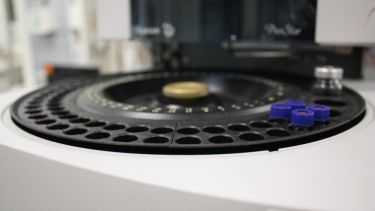Chromatography
The Chromatography Service is an analytical facility based in the School of Mathematical and Physical Sciences and is offered to all University of Sheffield schools, as well as external customers.

Services
Chromatography is a technique for separating and analysing chemical mixtures and the school's service comprises three main parts.
The first two are:
- High Performance Liquid Chromatography (HPLC) with either single wavelength, photodiode array, evaporative light scattering or differential refractive index detectors.
- Gas Chromatography (GC) with either flame ionisation or thermal conductivity detectors.
Both HPLC and GC usually require a minimum of 2mg of sample for routine analysis.
Peaks can be identified by running reference materials and quantitative analysis can be achieved by preparing standards. A range of stationary phases are available including chiral columns.
We also offer:
- Gel Permeation Chromatography (GPC) with differential refractive index detection, comparative molecular weight averages (from 500 to 2,000,000) can be determined using a range of columns and mobile phases calibrated with polystyrene standards. A minimum of 5mg is usually required for analysis.
Techniques
HPLC and GC can be used for purity checks, monitoring reactions, kinetics studies, quantitative analysis, purification, etc.
HPLC separates based mainly on sample polarity compared with GC which separates based mainly on sample volatility and whilst many samples can be analysed using either technique, there are some advantages/disadvantages to each technique that may mean one or the other is preferable.
Samples need to be relatively volatile (in general below 500 Daltons) and thermally stable under the analysis conditions for GC although the flame ionisation detector (FID) used will detect virtually anything (anything with carbon and hydrogen in the structure).
Sample structures that don’t contain carbon and hydrogen (for example, permanent gases) can be analysed using a thermal conductivity detector (TCD).
HPLC is a more universal technique although most instruments have a single wavelength UV/Vis detector meaning that the sample must have a chromophore in the structure to be detectable. However, one of the instruments is equipped with an evaporative light scattering detector (ELSD) which will detect virtually all non-volatile compounds.
Preparative HPLC can be very useful for purifying samples that prove difficult to purify by more conventional methods and can be performed once a suitable method has been determined analytically.
There is also a GPC system which separate primarily based on molecular weight and is used mainly for determining comparative molecular weight distribution information of polymers.
Contact
In the first instance please contact Joseph Quick, Technical Manager, who can discuss your query with you and direct you to the most appropriate member of our analytical services team.
Email: j.p.quick@sheffield.ac.uk
University of Sheffield customers should bring their samples along with a completed Internal service form and purchase order form (members of the members of the School of Mathematical and Physical Sciences do not need a purchase order form) to lab C43 in the Dainton Building.
Submission forms
External customers should send their samples along with a completed External service form, safety information and purchase order form.
